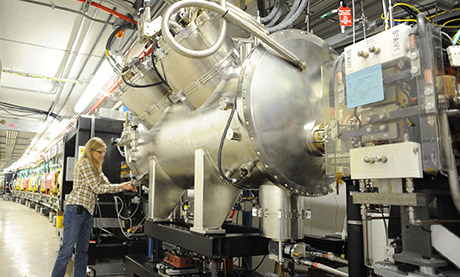|
More than eight years of effort by Advanced Photon Source (APS) physicists, engineers, and technicians culminated on January 21, 2013, with the production of the first x-rays from the prototype of a novel superconducting undulator (SCU), which has been installed in the APS storage ring at Argonne National Laboratory. It is the first such SCU operated at a third-generation synchrotron x-ray facility. |
Superconducting technology has been utilized before at synchrotron radiation facilities for building powerful wigglers or bending magnets, which are other types of synchrotron-x-ray-producing devices. But making small-period, strong-magnetic-field undulators that meet stringent field quality requirements has been a long-standing objective for accelerator science.
Original designs and technological solutions implemented in collaboration with the Budker Institute of Nuclear Physics in Russia led to the compact and efficient SCU device that has been installed and tested at Sector 6 of the APS. This device, approximately 0.35 m long, serves as the prototype for future 1-m- and 2-m-long SCUs that will be fabricated as critical components of the APS Upgrade project, which is supported by the U.S. Department of Energy Office of Science.
The immediate goal of developing novel SCUs is to significantly boost the brightness of high-energy x-ray beams that will be one of the important features of enhanced capabilities of the upgraded APS source. The deployment of innovative superconducting materials and technology will allow the APS to deliver unsurpassed x-ray brightness at energies between 50 and100 keV.
The new superconducting device was tested in a laboratory prior to installation in the APS accelerator. Its performance as a superconducting magnet exceeded design parameters in several areas. For example, the magnet delivers a field that is 20% stronger than the specification, which translates into a significantly wider tuning range and higher x-ray flux. After successful installation and operation in the APS ring, measurements of x-rays produced by the superconducting undulator had begun.
"This result makes me very excited about the future impact of superconducting undulators on research using hard x-rays," said APS Director Brian Stephenson. "The success of this novel device is a testimony to the ingenuity and dedication of the APS staff in developing new technology to enable the frontier science carried out by our users."
The APS is the premier high-energy synchrotron x-ray facility in U.S. The implementation of superconducting undulator technology, together with other aspects of the revolutionary APS Upgrade project, will ensure that the facility maintains its leadership in the future. The APS Upgrade will support the scientific breakthroughs needed to meet present and future challenges in energy, the environment, health, and our national security.

